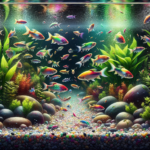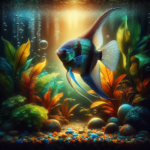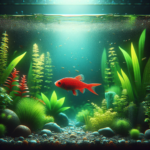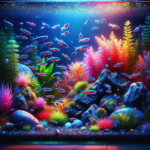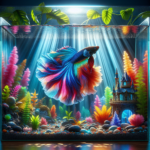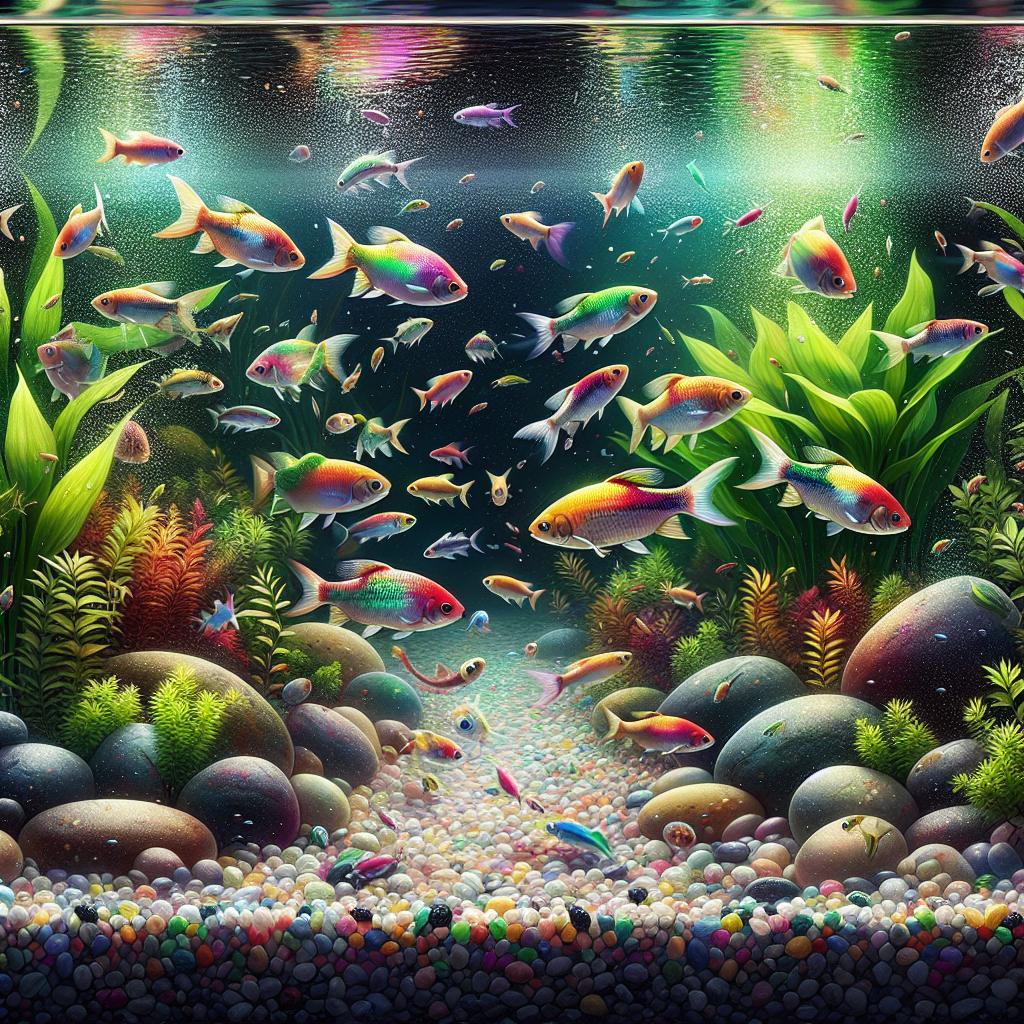
Key Takeaways
-
Rainbowfish thrive in tanks that are at least 30 gallons, but bigger is better for these active swimmers.
-
Substrate should be fine and dark-colored to mimic their natural habitat and enhance their colors.
-
Lighting is crucial, not just for plant growth but also to bring out the vibrant colors of your rainbowfish.
-
Stable water conditions with a pH of 6.5-8.0 and temperatures between 74-78°F are ideal for rainbowfish.
-
Customizing your tank with unique backgrounds and fixtures can create a visually stunning environment for both fish and observers.
Creating a custom rainbowfish tank is not just about housing these shimmering swimmers; it’s about crafting a vibrant underwater landscape that reflects their natural habitat and showcases their iridescent beauty. Let’s dive into how you can set up a tank that’s both a comfortable home for your fish and a stunning focal point in your space.
Deciding the Size of Your Rainbowfish Tank
Size matters, especially when it comes to the home of your rainbowfish. These fish are known for their active swimming habits and the more room they have to roam, the happier they’ll be. A cramped tank can lead to stress and health issues for your fish, so let’s make sure they have the space they need.
Minimum Tank Size for Rainbowfish
For starters, a 30-gallon tank is the absolute minimum for keeping rainbowfish. However, if you’re serious about providing the best environment for these colorful creatures, you should aim for a larger tank. A spacious tank doesn’t just cater to their swimming needs but also allows for a more stable aquatic environment, which is crucial for the well-being of your fish.
Calculating Tank Size Based on Rainbowfish Group
When it comes to the number of rainbowfish, a good rule of thumb is to have at least a 50-gallon tank for a group of six. These fish love company, so plan your tank size based on the group size you wish to keep. If you’re dreaming of a larger school of rainbowfish, then you’ll need to scale up your tank accordingly.
Designing the Perfect Habitat
The design of your rainbowfish habitat is not just for aesthetics; it’s crucial for their health and happiness. A well-thought-out habitat can make all the difference.
Choosing Substrate and Plants
When selecting a substrate, opt for a fine, dark-colored gravel or sand. Not only does it resemble the riverbeds of their natural habitat, but it also makes the colors of your rainbowfish pop. As for plants, rainbowfish enjoy a planted tank with plenty of space to swim freely. Choose plants like Java fern, Anubias, and water wisteria, which are easy to maintain and provide excellent cover for your fish.
Incorporating Hiding Spaces and Swim Areas
Creating hiding spaces is as important as having open areas for swimming. Use driftwood, rock formations, and plants to create nooks for your rainbowfish to explore and retreat to when they need a break. But remember to balance these with plenty of unobstructed space for swimming. Rainbowfish are active swimmers and they need room to move!
Illuminating Your Rainbowfish Tank
Lighting is not just a utility; it’s a vital component that can transform your tank into a dynamic ecosystem. Proper lighting enhances the natural beauty of your rainbowfish, making their colors more vibrant, and it also promotes the growth of live plants, which contribute to a healthy tank environment.
Best Lighting Practices for Color Enhancement
For the most striking visual effect, use full-spectrum LED lights. These not only mimic the natural light spectrum but are also energy-efficient and generate less heat. Position your lights to create a dappled effect, similar to sunlight passing through water in their natural habitat. This not only looks beautiful but also provides a more natural and comfortable environment for your rainbowfish.
The Balance of Light and Dark Periods
Maintaining a balance between light and dark periods is essential for the health of both your fish and plants. Aim for about 8-10 hours of light per day. Too much light can lead to algae growth, while too little can affect plant health. An automatic timer can be a handy tool to ensure a consistent light cycle.
Creating a Serene Water Environment
Water quality is paramount in any aquarium, but especially so in a custom rainbowfish tank. These fish are relatively hardy, but they still require stable water conditions to thrive.
Water Parameters for Rainbowfish Health
Keep your water parameters within the ideal range for rainbowfish: a pH of 6.5-8.0 and temperatures between 74-78°F. Regularly test your water to ensure these conditions remain stable. It’s also important to maintain a low level of nitrates and to perform regular water changes.
-
Test water parameters weekly.
-
Perform 20-25% water changes every two weeks.
-
Use a water conditioner to remove harmful chemicals from tap water.
Filter Options for a Clean and Quiet Tank
A good filtration system is the heart of a clean and healthy aquarium. Canister filters are a popular choice for rainbowfish tanks because they are powerful, can be easily hidden, and have customizable media for mechanical, chemical, and biological filtration. Sponge filters are another great option for smaller setups or as a supplementary filter, as they provide excellent biological filtration and gentle water flow.
When choosing a filter, consider the following:
-
The size of your tank: the filter should turn over the tank’s water volume at least 4-5 times per hour.
-
The bioload: a heavily stocked tank will require more filtration capacity.
-
Noise level: since rainbowfish are peaceful creatures, a quiet filter will help maintain a serene environment.
With the right conditions, your rainbowfish will display their most vivid colors and exhibit natural, stress-free behavior. A beautiful, well-maintained tank is a source of joy and relaxation, not just for the fish, but for everyone who views it.
Custom Features That Make Your Tank Unique
Beyond the essentials, custom features can turn your tank into a one-of-a-kind showcase. From backgrounds to fixtures, the possibilities to express your creativity are endless.
Adding Backgrounds and Custom Fixtures
A striking background can be the difference between a nice tank and a breathtaking one. Consider a 3D background that mimics natural rock or a planted backdrop to add depth and interest. As for fixtures, think about incorporating uniquely shaped driftwood or custom-crafted decorations that complement the colors and activity of your rainbowfish.
Digital Tools for Monitoring Tank Conditions
In today’s tech-driven world, digital tools can greatly simplify the management of your aquarium. Use digital thermometers and pH meters for accurate readings. Smart aquarium monitors can even alert you to changes in water parameters, helping you to keep your tank conditions perfect for your rainbowfish.
For example, a smart monitor could send an alert to your phone if the water temperature rises above the ideal range for rainbowfish, allowing you to take immediate action to correct the issue.
These custom features not only enhance the beauty of your tank but also contribute to the well-being of your rainbowfish by providing an environment that’s closer to their natural habitat.
The Economics of Rainbowfish Tank Setup
Setting up a custom rainbowfish tank is an investment in both time and money. Let’s break down the costs so you can plan accordingly.
Upfront Costs of Tank, Design, and Fish
Initially, you’ll need to budget for the tank itself, which can range from a few hundred dollars for a basic setup to several thousand for a large, custom-designed aquarium. The design elements such as substrate, plants, and decorations will add to the cost, as will the rainbowfish, which can vary in price depending on species and size.
Here’s a rough estimate:
-
Tank (30-50 gallons): $100-$500
-
Design (substrate, plants, decorations): $50-$300
-
Rainbowfish (per fish): $5-$20
Ongoing Expenses: Maintenance and Care
Besides the initial setup, there are ongoing costs to consider, such as food, water conditioners, test kits, and replacement filter media. Additionally, you may face occasional expenses like replacing a worn-out heater or upgrading your lighting system.
Typically, you might expect: Custom Rainbowfish Tank: Cost, Size & Design Options
-
Monthly food and supplies: $20-$50
-
Annual replacement items: $50-$100
Remember, while there are costs associated with setting up and maintaining a custom rainbowfish tank, the rewards of a thriving, colorful aquatic world are priceless. With careful planning and budgeting, you can create a stunning aquarium that brings endless enjoyment and relaxation.
Companion Species for Rainbowfish
Choosing the right tank mates for your rainbowfish can make your aquarium community thrive. Ideal companions are peaceful fish that won’t outcompete the rainbowfish for food or space. Good choices include small rasboras, tetras, and dwarf gouramis. Just ensure that any species you introduce have similar water requirements and are not fin-nippers, as rainbowfish have delicate fins.
Maintaining Peace: Regular Care Tips
Maintaining your custom rainbowfish tank goes beyond feeding and watching your fish swim. Regular care ensures a healthy environment, prevents disease, and keeps your tank looking its best. Let’s look at how to keep your tank clean and your fish happy without making it feel like a chore.
Scheduled Tank Cleaning Without Stress
Cleaning your tank regularly is key to preventing the build-up of harmful substances. Stick to a schedule that includes checking the filter weekly, vacuuming the gravel every other week, and doing partial water changes of about 20-25% monthly. By keeping on top of these tasks, you’ll avoid the need for major clean-ups and keep your fish stress-free.
Feeding Your Rainbowfish a Balanced Diet
Rainbowfish aren’t picky eaters, but they do need a varied diet to maintain their health and coloration. Feed them a mix of high-quality flake food, frozen or live foods like brine shrimp and daphnia, and vegetable matter. Feed small amounts twice a day, and only as much as they can consume in a few minutes to avoid overfeeding and polluting the tank.
FAQ
Got questions? You’re not alone. Here are some of the most common queries when it comes to setting up a custom rainbowfish tank.
What is the Ideal Number of Rainbowfish in a Custom Tank?
The ideal number of rainbowfish depends on the size of your tank. As a general guideline, aim for a group of at least six, which requires a minimum of a 50-gallon tank. Remember, more space is better, as these fish are active swimmers and enjoy being in groups.
For larger tanks, you can increase the number of fish proportionally. Just make sure to monitor water quality closely as you add more fish to ensure the tank’s ecosystem remains balanced.
Can Rainbowfish Be Paired with Other Fish Species?
Yes, rainbowfish can be paired with other peaceful community fish that share similar water parameters. Some compatible species include small rasboras, tetras, corydoras, and certain types of dwarf gouramis. Avoid aggressive fish or those with a tendency to nip fins, as they can stress or injure your rainbowfish.
How Often Should Water Parameters Be Tested?
Test your water parameters at least once a week to ensure they remain within the ideal range for rainbowfish. Pay close attention to pH, ammonia, nitrite, and nitrate levels. Regular testing allows you to catch and address any issues before they become harmful to your fish.
Consistency is key. Keeping a log of your test results can help you spot trends and make adjustments as needed.
What Are the Key Considerations When Choosing Tank Decor?
When selecting decor for your rainbowfish tank, consider the following:
-
Choose items that won’t affect water quality or pH levels.
-
Ensure decorations don’t have sharp edges that could injure your fish.
-
Include plenty of plants and hiding places to mimic the natural environment of rainbowfish.
-
Consider the adult size of your fish to ensure they have ample swimming space.
Are There Budget-Friendly Options for a Custom Rainbowfish Setup?
Setting up a custom rainbowfish tank doesn’t have to break the bank. You can save money by:
-
Starting with a smaller tank and upgrading as your budget allows.
-
Looking for second-hand tanks and equipment, but make sure they’re in good condition.
-
Choosing hardy, low-maintenance plants that won’t require costly CO2 systems or fertilizers.
-
Building your own tank decorations from safe, non-toxic materials.
Remember, the most important aspect of your tank is the well-being of your fish. Invest in quality where it counts, such as filtration and water conditioners, and you can get creative with the rest.
